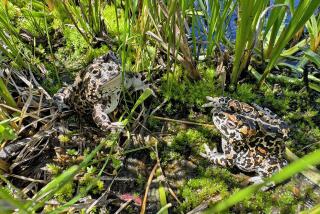Waste-Water Project Hinges on Rare Frog : Environment: Two biologists are scouting for the amphibian along Calleguas Creek. If the species is discovered, Thousand Oaks officials must take steps to protect it.
- Share via
Making their way to Calleguas Creek Thursday morning, the two biologists were the envy of every 8-year-old who likes mud puddles, turtles and frogs.
“It’s perfect frog weather,” Ventura ecologist Matt Ingamells said.
Ingamells and Simon Poulter were preparing for a muddy weeklong expedition along 15 miles of Calleguas and Conejo creeks.
Heading for the slippery banks where Calleguas empties into the ocean near Point Mugu, they threw oversize rubber boots into their truck and stuffed small fishnets, binoculars and other sundry items into a backpack.
The two were in search of the California red-legged frog, which is under consideration for listing as an endangered species.
The city of Thousand Oaks is trying to sell 10,000 acre-feet of treated waste water to the Calleguas Municipal Water District. In order to sell the reclaimed sewer water, city officials must first prepare an environmental impact report showing either that the creek is free of the red-legged frog or that its survival is ensured.
At least one frog expert believes the amphibian will not be discovered, which would be good news for the city.
“I seriously doubt they will find any,” said Mark Jennings of the California Academy of Sciences. Jennings added that the only known red-legged frog habitat south of the Santa Clara River is in Riverside County.
Most of the water in the creek is created by the city’s Hill Canyon waste-water treatment plant.
Always looking for new sources of water, Thousand Oaks officials five years ago approved a plan to sell the city’s waste water. After a lengthy legal battle with creek-side property owners and a slight change of plan, the city last year agreed to sell the waste water to the Calleguas Municipal Water District.
The district in turn hopes to sell it to two other districts, which will use the water for irrigation in the Oxnard Plain.
One of the last hurdles left to clear before the reclaimed water can be used is to determine the environmental impact of reducing the mostly man-made creek to a trickle.
*
Even if the three- to five-inch frog is not found, officials are 18 months away from using the reclaimed water, said Donald Kendall, general manager of the water district. Pump stations have to be constructed and pipes assembled and buried before the water can be moved.
There is also the possibility that the western pond turtle and an endangered songbird call the area home. If any of these species are found, the water district must devise a plan to ensure that the animals’ survive, as it must should the red-legged frog be found.
On Wednesday, the two water district-hired biologists came up short, even though the stakes were high.
“There’s a prize for the first guy to spot one,” Poulter said. “He gets to buy everyone else a beer.”
With that, the two scrambled down the side of the levee and waded gently--as gently as a 175-pound man in rubber boots can--across shallow pools to the edge of the flowing creek. Dipping his small net into the murky water, Ingamells trapped several tiny tadpoles. He lifted one of the tadpoles up to his eye, inspecting it as a jeweler might examine a tiny diamond.
*
“I’m pretty sure it’s a tree frog,” said the 38-year-old Ingamells. He checked Peterson Field Guides’ “Western Reptiles and Amphibians” to be safe. Sure enough, the captured tadpole’s distinct tail matched the illustration of a tree frog tadpole.
A tree frog is your garden-variety amphibian, which are found in declining abundance, Poulter said. He said the world’s frog population is slowly dying, and he blamed a deteriorating worldwide environment.
“They have their lungs on the outside,” he said. “Therefore, they’re more sensitive to the environment.”
And red-legged frogs are even more sensitive than tree frogs.
“Its species is in a world of hurt,” Jennings said, adding that the population has withered away by nearly 75% in the past 50 years.
For more than a year, federal wildlife officials have been considering classifying the frog as endangered, which means the species is close to extinction.
A decision, which is due at any time, is expected to be controversial.
As U.S. Fish and Wildlife Service spokeswoman Cindy U. Barry put it: “All California (environmental) issues are controversial.”
More to Read
Sign up for Essential California
The most important California stories and recommendations in your inbox every morning.
You may occasionally receive promotional content from the Los Angeles Times.













